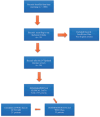Ophthalmic manifestations of nasopharyngeal carcinoma (NPC): A systematic review of reported cases with and without prior history of nasopharyngeal carcinoma
- PMID: 38451680
- PMCID: PMC11620173
- DOI: 10.5935/0004-2749.2022-0241
Ophthalmic manifestations of nasopharyngeal carcinoma (NPC): A systematic review of reported cases with and without prior history of nasopharyngeal carcinoma
Abstract
Purpose: We aimed to study reported cases of nasopharyngeal carcinoma presenting with ophthalmic manifestations with and without a prior diagnosis of nasopharyngeal carcinoma.
Methods: We conducted a systematic review following the Preferred Reporting Items for Systematic Reviews and Meta-Analyses (PRISMA). A literature search was conducted using the MEDLINE database in PubMed and Google Scholar. We included patients with a previous diagnosis of nasopharyngeal carcinoma in Group I and those without a prior diagnosis of nasopharyngeal carcinoma in Group II. Data included demographics, clinical presentation, history of nasopharyngeal carcinoma, treatment, histopathological description, World Health Organization classification, and outcome.
Results: Fifty-eight patients (26 in Group I and 32 in Group II) were included. The male-to-female ratio was 3:1. The mean age of the patients (53.3 ± 11.7 years and 54.8 ± 16.2 years, respectively) and gender did not differ significantly between the two groups. The most common ocular presentations were diplopia and proptosis in the first group (each in 34.6%), whereas visual disturbance was most common in the second group (46.9%). Treatment options and World Health Organization grading were comparable. The outcome in 38 patients (after a comparable follow-up period) was significantly better in group II (p=0.003). There was no statistically significant difference in the outcome of 23 patients in correlation with World Health Organization grades II versus III irrespective of group (p=0.094).
Conclusions: The demographics of patients with nasopharyngeal carcinoma presenting with ophthalmic manifestations were similar between the two study groups, with a wide age range and male predominance. Patients presenting initially to ophthalmologists with no history of nasopharyngeal carcinoma have a more favorable outcome. World Health Organization grading may have less value as a prognostic indicator.
Conflict of interest statement
Figures



Similar articles
-
Nasopharyngeal carcinoma (NPC) in the ophthalmic practice: A serious neoplasm presenting initially to ophthalmologists.Saudi J Ophthalmol. 2022 Apr 18;35(3):225-229. doi: 10.4103/1319-4534.343369. eCollection 2021 Jul-Sep. Saudi J Ophthalmol. 2022. PMID: 35601850 Free PMC article.
-
Prognostic value of EGFR and p-EGFR in nasopharyngeal carcinoma: A systematic review and meta-analysis.Medicine (Baltimore). 2022 Jan 21;101(3):e28507. doi: 10.1097/MD.0000000000028507. Medicine (Baltimore). 2022. PMID: 35060503 Free PMC article.
-
Neuro-ophthalmic manifestation of nasopharyngeal carcinoma at Ilorin: a five year review.Niger J Clin Pract. 2008 Dec;11(4):376-8. Niger J Clin Pract. 2008. PMID: 19320415
-
Isolated unilateral sixth nerve palsy in a patient with nasopharyngeal carcinoma.Rom J Ophthalmol. 2019 Oct-Dec;63(4):375-378. Rom J Ophthalmol. 2019. PMID: 31915737 Free PMC article.
-
Prevalence of Nasopharyngeal Carcinoma in Patients with Dermatomyositis: A Systematic Review and Meta-Analysis.Cancers (Basel). 2021 Apr 14;13(8):1886. doi: 10.3390/cancers13081886. Cancers (Basel). 2021. PMID: 33919987 Free PMC article. Review.
References
-
- Lee KY, Seah LL, Tow S, Cullen JF, Fong KS. Nasopharyngeal carcinoma with orbital involvement. Ophthalmic Plast. Reconstr. Surg. 2008;24(3):185–189. - PubMed
-
- Chong VF, Mukherji SK, Ng SH, Ginsberg LE, Wee JT, Sham JS, et al. Nasopharyngeal carcinoma: review of how imaging affects staging. J Comput Assist Tomogr. 1999;23(6):984–993. - PubMed
-
- Alrashed SH, Alkatan HM, Alarfaj M, Alnahdi MA, Almeshari NZ, Almutairi FJ, et al. Nasopharyngeal carcinoma (NPC) in the ophthalmic practice: A serious neoplasm presenting initially to ophthalmologists. [cited 2022 Sep 15];Saudi J Ophthalmol [Internet] 2021 35:225–229. Available from: Nasopharyngeal carcinoma (NPC) in the ophthalmic practice: A serious neoplasm presenting initially to ophthalmologists - PMC (nih.gov) - PMC - PubMed

